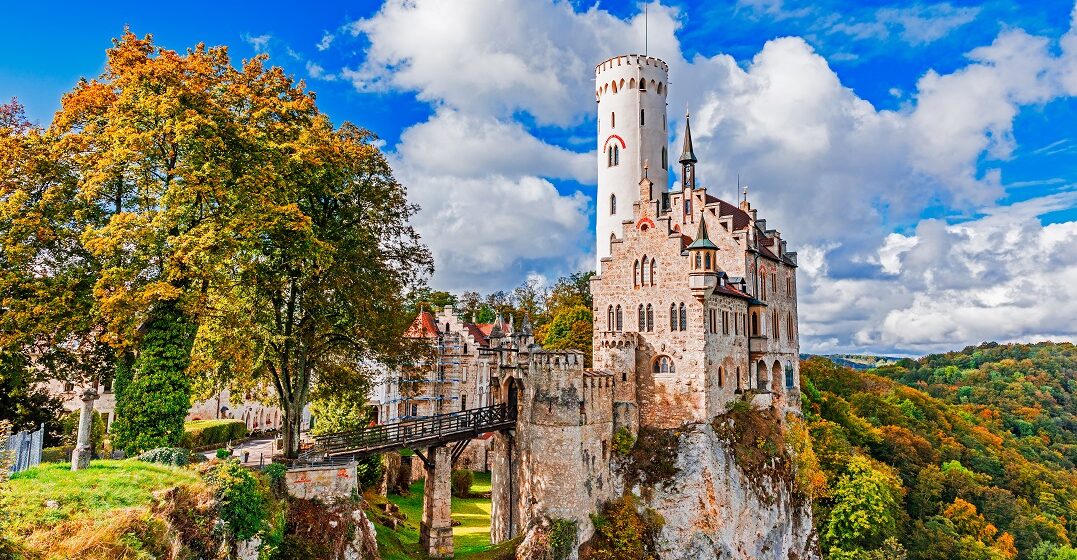How many castles are there in Germany?

Among Germany’s vast forests and impressive medieval towns lie its enchanting castles. Thousands of them. In fact, there are around 20,000 castles in Germany, possibly as many as 25,000. From glorious Neuschwanstein, which inspired Disney’s Cinderella and Sleeping Beauty castles, to the ancient Nuremberg Castle, where parts date back to the 11th century, these palaces and castles are endlessly fascinating for tourists and locals alike. Many of them are still home to noble families today. Let’s learn more about Germany’s famous castles and where you can find them.
- Neuschwanstein Castle
- Hohenzollern Castle
- Eltz Castle
- Lichtenstein Castle
- Nuremberg Castle
- Wartburg Castle
- Heidelberg Castle
Learn languages at your pace
Can you count Germany’s castles?
It’s proved very difficult to put an exact figure on the number of castles in Germany, though most reputable sources have landed on a figure of between 20,000 and 25,000. The buildings stand as witnesses to Germany’s past, from the atmospheric ruins of medieval strongholds to the well-preserved fortifications that now serve as wedding venues and tourist attractions. Many of Germany’s castles are UNESCO World Heritage Sites, including Wartburg, which is on our list.
7 of the most beautiful German castles
1. Neuschwanstein Castle
Let’s start with the German castle of Neuschwanstein, possibly the most recognizable German castle. Its fairytale-like towers watch over the village of Hohenschwangau, Bavaria, and the castle stands on a steep stone outcrop, with a backdrop of trees and dramatic mountains. Neuschwanstein was built by King Ludwig II in the late 19th century and has been open to the public since 1886.
2. Hohenzollern Castle
The vast and imposing Hohenzollern Castle is a 19th-century palace fit for a king. In fact, it is the ancestral seat of the Prussian Royal House and the Hohenzollern Princes. It’s in a picturesque setting on top of a hill on the edge of the Swabian Alps. Inside the castle, you’ll find opulently decorated rooms, with painted ceilings, golden chandeliers and stained-glass windows adorning many of them.
3. Eltz Castle
Magnificent Eltz Castle is an absolute must-see when you go to Germany. Its turrets and towers rise up out of a deep forest that’s changed little since plans for the castle were first laid out in the 12th century. What makes this castle even more special is its history; it’s been in the possession of the Eltz family for nine centuries and has been added to but never destroyed. Fun fact: Eltz Castle was on the back of Germany’s 500 Deutsche Mark note for many years.
4. Lichtenstein Castle
One of the most dramatically situated castles on the list is Lichtenstein. It rises on an almost sheer cliff, 250 meters above the Echaz river. It’s an impressive neo-Gothic structure that was built between 1840–1842 near the site of a medieval castle.
Learn languages at your pace
5. Nuremberg Castle
The rise and fall and rise again of Nuremberg Castle make for a fascinating journey of discovery. In medieval times, Nuremberg was considered a center of the Holy Roman Empire, and the castle hosted many of its leaders. Its importance declined over the following centuries and, during World War II, it was almost completely destroyed. Since then, it has been rebuilt in its original style and is a lovely monument to visit in Nuremberg.
6. Wartburg Castle
UNESCO calls Wartburg ‘the ideal castle’, so you know something special lies here in Thuringia. Like many of the castles on our list, it stands on a steep hill and has scenic views over the countryside around it. Much of the structure dates as far back as the 12th century, while the interior of the castle was renovated in the 19th. This castle is famous among Lutherans, as it is the place where Martin Luther made his translation of the New Testament.
7. Heidelberg Castle
Heidelberg is one of the historically unluckier castles on our list. Parts of it were destroyed when struck by lightning bolts over two hundred years apart, while in the intervening period, war and fire ravaged the buildings too. Despite its turbulent history, the castle is still an impressive Renaissance monument and a joy to explore; you’ll get to see such oddities as The Witch’s Bite and the incredible Heidelberg Tun, an enormous wine vat that can hold 219,000 liters of liquid.
Which castle in Germany do you want to visit?
Are you more attracted by the fairytale qualities of Neuschwanstein or the long history of Eltz Castle? If you want to see a classic castle and learn more about the country’s religious history, Wartburg is a must-visit, while Hohenzollern is a great choice if you love 19th-century grandeur. All of Germany’s castles, from the most famous to the little-known, offer visitors a chance to connect with the past.














